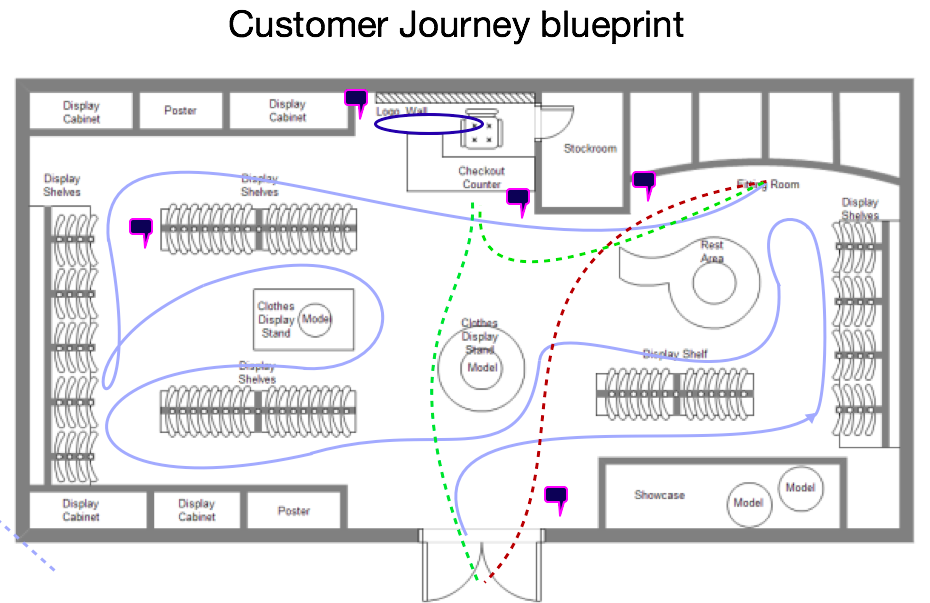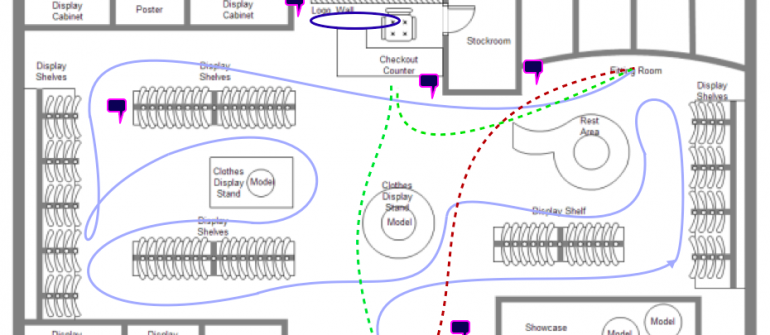Improving your survey placement
Do you ever wonder how you can receive quality answers and a lot of them? Well, one of the low-hanging fruits is simply by improving your survey placement.
”Quality questions create a quality life. Successful people ask better questions, and as a result, they get better answers.” – Anthony Robbins
While asking the right question is the beginning to all great insights, asking them at the right time and place is also crucial. This is probably a larger truth with a stationary system like tabsurvey that has no human administration. Today’s blog look at the customer journey and help you blueprint when and where to ask your questions.
The customer journey
In the figure below, we have outlined a typical customer journey from entering a store to exit. The blue line shows how visitors move with the store, green is the purchase movement while red represents customers who leave without purchase. We give your 3 perspectives to focus on when planning the location of your stationary survey; the focus, experience conclusion and response pain. The purple/blue text bubbles represent indications of where you could place your survey system.

The start to improving your survey placement is analyzing the focus of the survey: Who do you wish to respond and what are they responding to? These two are very interlinked and are a sense of focus for your measurements. Are you interested in the perception of staff from your purchasing customers? Or is it the general customer perception of staff? Are you interested in customers’ response to new initiatives? Are those initiatives target towards a certain function (ex. Queue-time, cleanliness etc.) Or are they geared towards types of customers (ex. Purchasing customers, none-purchasing customers, indecisive customers using fitting room etc.). Understanding the focus of your survey in relation to the physical location is the first step towards more answers of high quality.
The second perspective to consider is when to give people the survey. It doesn’t make sense to ask customers if the fitting room was clean just before they go into the fitting room. In the same vein, asking customers about the purchase experience before they have purchased or in the midst of it, makes little sense. We argue that the ideal placement of your survey is what we term experience conclusion. When the focus of your survey has transpired. This however creates another issue, since customers prepare to leave the store or they shift their attention towards the next thing on their agenda. Finding that sweet spot between the conclusion of one thing and before customers begin engaging in a new task, is the ideal place for your survey with the least response pain.
Decrease response pain
“Response pain?” You ask. Response pain has its roots grounded in customer behavior, choice architecture and psychology. There are several aspects to the notion of customer’s pain in responding that is relevant when designing a survey system. For todays post, we go into one of the aspects. The notion builds on the issues (pains) that emerge internally with interaction; when customers are forced to choose, interrupted mid-action or are prompted to invest time and energy into others. You can think of response pain as the level of intrusiveness.
A good example is when a telemarketer calls you during dinner. Irritating right? As a general rule, response pains are the negative feelings that arise from an interaction. In a similar view, response pain can increase when/if a customer feels he/she is intrusive towards others. Nobody wants to answer a survey in a busy aisle, especially if it is a bother to others. Decreasing the customer’s response pain is therefore paramount to collect more answers and establish positive feelings around your survey system.
‘The question is then, how do you go about it? One way that we have seen used successfully is to analyze the flow in your store. Dedicate time to observe how customers move around in your store, both when there are a lot of customers as well as few. Keep in mind the focus of your survey and finding the sweet spot where the experience has concluded. It is worth noting that completely eliminating customer response pain is implausible. It can for easy understanding be viewed more as a trade-off between response pain and experience conclusion.
Summary
Finding ways to improving your survey placement is all about balancing the 3 elements of survey placement to find your surveys’ sweet spot. Our best advice is to observe the movement patterns in your store and locate that natural pause briefly after the conclusion of the experience that matches your focus for the survey. Today’s post assumes the store manager perspective, however the views remains just as valid if you conduct surveys internally amongst your employees.
Stay tuned for our next blog on attracting more customers to your survey and the actual survey and customer experience.
